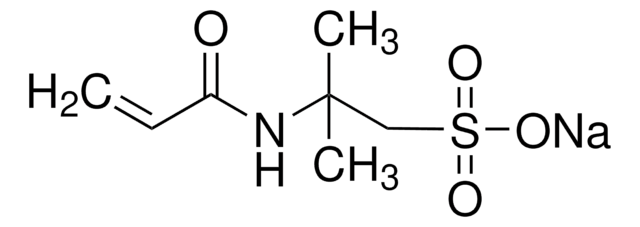448281
(3-Acrylamidopropyl)trimethylammonium chloride solution
75 wt. % in H2O
Sinónimos:
(Acrylamidopropyl)trimethylammonium chloride, Acryloylaminopropyltrimethylammonium chloride, Trimethyl(3-acrylamidopropyl)ammonium chloride
About This Item
Productos recomendados
contiene
3,000 ppm monomethyl ether hydroquinone as stabilizer
concentración
75 wt. % in H2O
índice de refracción
n20/D 1.4848
densidad
1.11 g/mL at 25 °C
temp. de almacenamiento
2-8°C
cadena SMILES
[Cl-].C[N+](C)(C)CCCNC(=O)C=C
InChI
1S/C9H18N2O.ClH/c1-5-9(12)10-7-6-8-11(2,3)4;/h5H,1,6-8H2,2-4H3;1H
Clave InChI
OEIXGLMQZVLOQX-UHFFFAOYSA-N
Categorías relacionadas
Descripción general
Aplicación
- As a cationic monomer to synthesize polyampholyte hydrogels (PAHs). These hydrogels show pH-responsive and ionic strength-responsive behavior and are suitable for application in smart coatings and biosensors.
- As a monomer to prepare poly(APTAC) ion exchange membranes with high surface porosity, for the removal of Cu(II), Cr(VI), and As(V) ions from water.
- As a precursor to fabricate cartilage mimetic polymer scaffolds that can be used in cartilage regeneration and replacement.
Frases de peligro
Consejos de prudencia
Clasificaciones de peligro
Aquatic Chronic 3
Código de clase de almacenamiento
10 - Combustible liquids
Clase de riesgo para el agua (WGK)
WGK 1
Punto de inflamabilidad (°F)
Not applicable
Punto de inflamabilidad (°C)
Not applicable
Elija entre una de las versiones más recientes:
¿Ya tiene este producto?
Encuentre la documentación para los productos que ha comprado recientemente en la Biblioteca de documentos.
Los clientes también vieron
Nuestro equipo de científicos tiene experiencia en todas las áreas de investigación: Ciencias de la vida, Ciencia de los materiales, Síntesis química, Cromatografía, Analítica y muchas otras.
Póngase en contacto con el Servicio técnico![[2-(Acryloyloxy)ethyl]trimethylammonium chloride solution 80 wt. % in H2O, contains 600 ppm monomethyl ether hydroquinone as inhibitor](/deepweb/assets/sigmaaldrich/product/structures/393/326/f7e19585-5431-4220-81b5-f458de6d63d0/640/f7e19585-5431-4220-81b5-f458de6d63d0.png)
![[2-(Methacryloyloxy)ethyl]trimethylammonium chloride solution 75 wt. % in H2O](/deepweb/assets/sigmaaldrich/product/structures/316/612/66b0f4cf-d060-427d-b4f5-e8fab3e5cffe/640/66b0f4cf-d060-427d-b4f5-e8fab3e5cffe.png)
![[3-(Methacryloylamino)propyl]trimethylammonium chloride solution 50 wt. % in H2O](/deepweb/assets/sigmaaldrich/product/structures/189/736/089bc8ae-2a98-416d-9f9a-a0a510b6b828/640/089bc8ae-2a98-416d-9f9a-a0a510b6b828.png)


![[2-(Methacryloyloxy)ethyl]dimethyl-(3-sulfopropyl)ammonium hydroxide 95%](/deepweb/assets/sigmaaldrich/product/structures/217/219/73c91e1c-0ee4-4b3d-bead-a6dc3d09d1da/640/73c91e1c-0ee4-4b3d-bead-a6dc3d09d1da.png)









![N-[Tris(hydroxymethyl)methyl]acrylamide contains ≤7% KCl, 93%](/deepweb/assets/sigmaaldrich/product/structures/130/961/5bc6d1a4-a540-4496-9f46-74507af67e21/640/5bc6d1a4-a540-4496-9f46-74507af67e21.png)